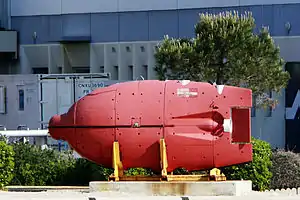 Épaulard at La Seyne-sur-Mer | |
| History | |
|---|---|
| Name | Épaulard |
| Namesake | Killer whale |
| Owner | Ifremer |
| Builder | ECA Group[1] |
| Commissioned | 1980[2] |
| General characteristics | |
| Class and type | remotely operated underwater vehicle |
| Displacement | 3 tonnes[2] |
| Length | 4 metres [2] |
| Beam | 1.1 metres[1] |
| Height | 2 metres[1] |
| Depth | 6000 m [2] |
| Propulsion | Sail |
| Speed | 1 m/s[1] |
| Range | 20 km[2] |
| Endurance | 7 to 12 hours[1][2] |
| Sensors and processing systems | 5000-shot BENTHOS 377 photographic camera[1][2] |
| Armour | Aluminum[3] |
Épaulard is a French remotely operated underwater vehicle of the Ifremer. She was the first robotic submarine capable of taking photographs at a depth of 6000 metres. Built in 1980, Épaulard was decommissioned in 1991.
Design
Épaulard was designed and built by ECA Group[1] She was teleoperated from a support ship by means of acoustic signals.[2] While the submarine herself displaced three tonnes, the entire system would use up 35m² of deck space and weight 20 tonnes; such systems were installed on a number of Ifremer ships such as Noroît, Suroît, Atalante or Jean Charcot.[2]
In 1983, she was upgraded with a vertical propeller and a remote TV system with acoustic broadcast of images.[2]
Career
Starting in 1981, Épaulard was used for the study of nodules and shipwrecks on the Pacific seafloor.[2]
She was decommissioned in 1991, having performed 200 missions.[2]